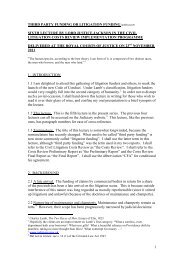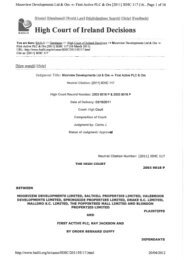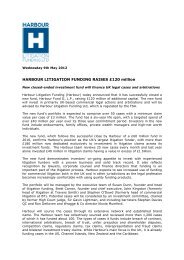Neutral Citation Number: [2010] EWHC 941 (QB) - Harbour ...
Neutral Citation Number: [2010] EWHC 941 (QB) - Harbour ...
Neutral Citation Number: [2010] EWHC 941 (QB) - Harbour ...
- No tags were found...
You also want an ePaper? Increase the reach of your titles
YUMPU automatically turns print PDFs into web optimized ePapers that Google loves.
<strong>Neutral</strong> <strong>Citation</strong> <strong>Number</strong>: [<strong>2010</strong>] <strong>EWHC</strong> <strong>941</strong> (<strong>QB</strong>)Claims no: 9SF02648, 9SF02506,9MA10331 and 9SF02121IN THE HIGH COURT OF JUSTICE QUEEN’S BENCH DIVISION MANCHESTERDISTRICT REGISTRY MERCANTILE COURTBefore:HIS HONOUR JUDGE WAKSMAN QC (sitting as a Judge of the High Court)Date: 29 April <strong>2010</strong>BETWEEN:MOHAMMED ADRISSHELAGH BROWNLOWRAJAN MANDALIAIN MCNICOLClaimantsandTHE ROYAL BANK OF SCOTLAND PLCDefendantsand(1) CARTEL CLIENT REVIEW LIMITED(2) RICHARD BURLEYtrading as CONSUMER CREDIT LITIGATION SOLICITORS(3) MR CARL WRIGHTAdditional PartiesAND BETWEEN:Claim no: 9MA11185ROBERT ATKINSONClaimantandBANK OF SCOTLAND PLC
Additional PartiesDefendantand(1) CARTEL CLIENT REVIEW LIMITED(2) RICHARD BURLEYtrading as CONSUMER CREDIT LITIGATION SOLICITORS(3) MR CARL WRIGHTAdditional PartiesAND BETWEEN:Claim no: 9MA07104MR ANDREW MILLSClaimantandMARKS AND SPENCER FINANCIAL SERVICES PLCDefendantand(1) CARTEL CLIENT REVIEW LIMITED(2) RICHARD BURLEYtrading as CONSUMER CREDIT LITIGATION SOLICITORS(3) MR CARL WRIGHTAND IN THE MANCHESTER COUNTY COURTBefore:HIS HONOUR JUDGE WAKSMAN QCClaim Nos: 9MA07731 (Layton v RBS); 9MA10155 (Barks v RBS); 9MA10192 (Taylor vRBS); 9MA10330 (Gotts v RBS); 9MA10654 (Sheeran v RBS); 9MA11047 (Hodgkins vRBS); PMA08210 (Richardson v NatWest); 9SF01519 (Parry v NatWest); 9SF02559(Lippiatt v NatWest); 9SF02397 (Braley v NatWest); 9TS02035 (Whittaker v NatWest);9TS02102 (Obilade v RBS); 9AL03639 (Partt v RBS); 9MA13594 (Sykes v RBS);9MA15036 (Cooper v NatWest); 9MA16652 (Kyei v RBS); 9TS01646 (Thompson v RBS);9BL01330 (Wernham v NatWest); 9MA10227 (Anthony Whittaker v RBS); 9BL01563(Rosalind Whittaker v RBS); 9AL01717 (Scales v RBS); 9TS01926 (Skellett v RBS);
9SF03912 (Penketh v RBS); 9TS01604 (Riley v NatWest); 9SF02654 (Ritchie v NatWest);9TS01770 (Jones v NatWest); 9TS01757 (Gilbert v RBS) ; 9MA 07741 (Edmondson v BoS);9MA 07739 (Kerr v BoS); 9MA 08502 ( Potts v BoS); 9MA 07501 (Tasker v BoS); 9SF02643 (Broadman v Lloyds TSB); 9MA10228 (Samuel Clark v HSBC); 9SK03194 (ChristineMonk-Slocombe v HFC); 9MA10157 (Jodie Mills v HSBC); 9MA10652 (Christopher Hicksv HSBC); 9SK03035 (Karl Byers v HSBC); 9SK03421 (Karl Byers v HFC); 9SK03389(Richard Batson v HFC); 9SK03404 (Naini Ahluwalia v HSBC t/a First Direct); 9TS01772(Gavin Feaver v HSBC); 9MA11617 (Marcus Morgans v HSBC); 9SK03661 (Scott DavidCollins v HSBC); 9TS01733 (Keith Dickenson v HSBC); 9MA11979 (Raj Khan v HSBC);9MA12214 (Anthony Blackler v HSBC); 9MA12544 (William Henry Guthrie v HFC);9SK04021 (Michael McCullagh v HSBC); 9SK04092 (Deborah Dalton v HSBC); 9MA14453(Matthew Fletcher v HSBC); 9SK02498 (Maureen Beal v HSBC); 9TS01425 (SusanWheelhouse v HSBC); 9SK04627 (Aran Curry v HSBC); 9SK03122 (Yvonne Sleight vHSBC); 9TS01436 (Amanda Freeman v HSBC); 9SK02993 (Philip Hadland v HFC);9SK02636 (Michael Love v HSBC); 9SK02563 (David Richardson v HSBC); 9SF03651(Douglas Fairbairn v HFC); 9MA07798 (Julian Trodden v HSBC); 9MA15964 (WendyMitchell v M&S); 9SK03621 (Mark Loveridge v HSBC); 9SK02543 (David Miller v HSBC);9SK03954 (Lee Robey v HSBC); 9SK03307 (Emma Wright v John Lewis); 9BI05479(Jonathan Potter v HSBC); 9SF 02686 (Abraham v Lloyds TSB); 9MA 13514 (Douglas vLloyds TSB); 9MA 17781 (Maddren v Lloyds TSB); 9SK 04192 (Purves v Lloyds TSB);9MA 12520 (Braund v BoS); 9MA 11044 (Curry v BoS); 9MA 09906 (Green v BoS); 9MA14731 (Joyce v BoS); 9MA 11260 (Lee v BoS); 9MA 12671 (Morton v BoS); 9MA 14106(Smee v BoS); 9MA 11031 (Taylor v BoS); 9MA 07555 (Blackman v HBOS); 9MA 12545(Hitcham v Sainsbury’s Bank PLC); 9MA 10492 (Pearce v Sainsbury’s Bank Plc).-----------------------------------------------------------Julia Smith (instructed by DLA Piper (UK) LLP Solicitors) for The Royal Bank of ScotlandPlc James MacDonald (instructed by Addleshaw Goddard LLP Solicitors) for HSBC BankPlc and Marks and Spencer Financial Services PlcFred Philpott (instructed by SCM Solicitors) for Bank of ScotlandPlc Julie-Anne Luck (instructed by Slater Heelis Solicitors) for MrWright Mr Burley appeared in person on 24 March <strong>2010</strong>Hearing dates: 24 and 25 March <strong>2010</strong>
INTRODUCTION1. Cartel Client Review Limited (“CCR”) is a claims management company. At allmaterial times it was authorised by the Ministry of Justice to carry on the business ofclaims management. On 18 March <strong>2010</strong> that authorisation was suspended. The soleshareholder in and Managing Director of CCR at all times has been Mr Carl Wright.Consumer Credit Litigation Solicitors (“CCLS”) is the trading name for a solesolicitor’s practice carried on by Mr Richard Burley. It was expressed to be a“division” of a pre-existing practice carried on by him in Nottingham called Burleys.On 10 March <strong>2010</strong> both “divisions” or offices of Mr Burley’s practice were intervenedby the Solicitors’ Regulation Authority (“SRA”).2. On 23 December 2009 I handed down a lengthy judgment in Carey v HSBC [2009]<strong>EWHC</strong> 3417 which dealt with various issues arising in a very large number of CountyCourt cases in relation to s78 of the Consumer Credit Act 1974 (“the 1974 Act”). Thehearing to which that judgment related took place over 5 days commencing on 30November 2009. Some of the Claimants involved in that hearing had made theirclaims as a result of initial contact and involvement with CCR. They were representedin relation to their claims both before and at the hearing by CCLS. On 2 February <strong>2010</strong>I made various costs orders consequential upon that judgment, some of which wereagainst those Claimants. There is also a large number of other claims made byClaimants through CCR and CCLS. Some of those have now been discontinued. On 23March <strong>2010</strong> I handed down a related judgment in the case of Teasdale v HSBC [<strong>2010</strong>]<strong>EWHC</strong> 612. This dealt with applications made by a number of discontinuingClaimants (including those involved with CCR and for whom CCLS had acted) forsome or all of their costs to be paid by the Defendant banks. I dismissed all of thoseapplications with costs.3. On 2 February <strong>2010</strong> I also permitted CCR and CCLS to be joined as additional partiesin various actions for the purpose of an application for a non-party costs order(“NPCO”) made against them made by The Royal Bank of Scotland Plc (“RBS”) inrelation to three cases. On the same occasion I permitted their joinder, and that of MrWright, for the purpose of a similar application to be made by Lloyds TSB Bank Plcand Bank of Scotland Plc (“HBOS”) in relation to five other cases. On 8 and 9 March<strong>2010</strong> I permitted the joinder of those parties in respect of yet further applications forNPCOs made by RBS, NatWest Bank Plc (“NatWest”), HBOS and HSBC and otherbanks or finance companies associated with or which form part of those bankinggroups. The upshot was that on 24 and 25 March <strong>2010</strong> I heard substantive applicationsfor NPCOs by RBS/NatWest, HBOS and HSBC in effect in relation to the costsincurred by them in respect of all the claims made, or transferred into the ManchesterCounty or Mercantile Court where the Claimants had been represented by CCLS. Ineach such case the relevant claims management company was CCR. Theseapplications are made whether the Court had already made a substantive costs orderagainst the individual Claimant (as it has in the cases involved in the hearings leadingto the judgments in Carey or Teasdale) or not.
proceedings but substantially also controls or at any rate is to benefit fromthem, justice will ordinarily require that, if the proceedings fail, he will pay thesuccessful party's costs. The non-party in these cases is not so much facilitatingaccess to justice by the party funded as himself gaining access to justice for hisown purposes. He himself is "the real party" to the litigation, a conceptrepeatedly invoked throughout the jurisprudence... (4) Perhaps the mostdifficult cases are those in which non-parties fund receivers or liquidators (or,indeed, financially insecure companies generally) in litigation designed toadvance the funder's own financial interests......29 In the light of these authorities their Lordships would hold that, generallyspeaking, where a non-party promotes and funds proceedings by an insolventcompany solely or substantially for his own financial benefit, he should beliable for the costs if his claim or defence or appeal fails. As explained in thecases, however, that is not to say that orders will invariably be made in suchcases, particularly, say, where the non-party is himself a director or liquidatorwho can realistically be regarded as acting rather in the interests of thecompany (and more especially its shareholders and creditors) than in his owninterests.8. In Goodwood Recoveries Ltd v Breen [2006] 1 WLR 2723, the Court of Appeal dealtin particular with two aspects of this jurisdiction, namely the liability of companydirectors and the question of causation. On the first, Rix LJ (with whom May LJagreed) said this after reviewing the authorities:59 In my judgment, it is clear from these passages that the law has moved aconsiderable distance in refining the early approach of Lloyd LJ in Taylor vPace Developments Ltd [1991] BCC 406. Where a non-party director can bedescribed as the "real party", seeking his own benefit, controlling and/orfunding the litigation, then even where he has acted in good faith or withoutany impropriety, justice may well demand that he be liable in costs on a factsensitiveand objective assessment of the circumstances. It may also be notedthat in Lord Brown's comments in the Dymocks case [2004] 1 WLR 2807, para33 "the pursuit of speculative litigation" is put into the same category as"impropriety".9. As to causation, in paragraph 61, Rix LJ referred to the judgment of Morritt LJ inGlobe Equities v Globe Legal Services [1999] BLR 232 where he said at p234 that thecosts claimed must have been caused “to some extent” by the non-party but did not seewhy they must be caused by all the factors which rendered the case exceptional. Atparagraph 62 he referred to the judgment of Chadwick LJ in Byrne v Sefton Heath[2002] 1 WLR 775 where at paragraph 35 he said that there must be a “sufficientcausal link” between the costs at issue and the non-party, whose conduct should be“really an effective cause of the costs incurred.” In paragraph 64 he referred toparagraph 20 of Lord Brown’s judgment in Dymocks [supra]. He concluded that if onewere to apply that latter “but for” approach, it was in fact satisfied in the case beforehim. Otherwise, he stated in paragraph 65 that the issue of causation as raised byMorritt LJ in Globe Equities (supra) has not received a “determinative decisionbinding on this court”.10. In Arkin v Borchard Lines [2005] 1 WLR 3055, Lord Phillips MR giving the judgmentof the Court of Appeal said this:
30% was payable to CCR as a success fee.19. If a client was attracted to CCR’s service, there would be an initial questionnaire to fillin about the credit card agreement which would be evaluated free of charge by CCR. IfCCR thought that there was a possibility or a good chance of a successful claim itwould inform the client. If the client wished to pursue it through CCR it would have tosign a client agreement whose terms are at pp569-572 of the Bundle. Under thatagreement the client would have to pay a fee to CCR for a more extensive review ofhis case. This was stated to be £495 or £175 if the client had used CCR before. Inpractice, according to Mr Wright, only about 50% of the fees paid were at £495 andthe others were at £150 - £175. If, after that review, CCR considered that there was noreasonable prospect of a successful claim it would cancel the contract and the clientwould get a refund. If it thought that there were reasonable prospects the claim wouldbe referred to solicitors, in practice CCLS. If the claim failed then the client was alsoentitled to a refund. When CCR referred a case to CCLS, the latter was obliged to payit a referral fee. So the whole scheme was on the basis that even if a client did not win,he would not lose anything.20. CCR also had a network of referrers who marketed its services to potential clients.They were paid a commission for their introduction of a client to CCR but had to payinitial fees to CCR for the right to be an agent and for software and other support.21. Thus the potential income stream to CCR was from (a) initial fees from clients (b) feesfrom referrers (c) fees from CCLS and (d) if a claim succeeded, 30% of the sumawarded or written off.CCLS’s modus operandi22. When it took over a file from CCR, CCLS became responsible for the claim. In orderfor the operation to work in terms of issuing and progressing claims it needed fundingfor its own considerable administrative costs and disbursements such as court fees andcounsel’s fees. This was provided in the form of loans from CCR. They totalled £3.6mbetween 22 September 2008 and 9 March <strong>2010</strong>, of which just over £180,000 has beenrepaid. The lending was unsecured and formalised by a written Facility Agreementdated 17 June 2009 which provided for a facility of up to £4m, repayable within 12months of a demand and attracting interest at 2% above base p.a.23. By a further written Referrer Agreement of the same date, the referral arrangementsbetween CCR and CCLS were formalised. It was expressed to have commenced as at1 January 2008. By Clause 2.2 CCR undertook to supply CCLS (referred to here asBurleys) with claims from time to time. CCLS was entitled to reject any claim within7 business days of receipt if it did not pass CCLS’s initial vetting. In the absence of arejection CCLS was deemed to have accepted the claim. In the next 90 days, CCLShad a further right to reject the claim provided that “Unwind Criteria” were met. Theseincluded a material change of fact which detrimentally affected the chances of successof a claim such as a change in the law or insufficient evidence from a client. By Clause7.7 CCLS agreed to progress all claims. If it obtained profit costs of more than £750from a claim, the referral fee of £500 was payable to CCR and this reduced if the profitcosts were less. The services to be provided by CCLS were set out in some detail inthe Schedule and they included the appointment and payment of all appropriateexperts. Paragraph 3 set out the Service Levels which included extensive reportingobligations on CCLS towards CCR.
24. It was put to Mr Burley that such provisions in effect gave real or substantial controlover the claims to CCR and that he was in breach of Rule 9.02 (d) of the Solicitors’Code of Conduct 2007 (introducer influencing or constraining the solicitor’sprofessional judgment in relation to the advice given to the client) as a result. MrBurley rejected this on the basis that whatever may have been the terms of the ReferrerAgreement, in practice, CCLS was free to reject any claim whenever it wished and itfrequently did so without any comeback from CCR, which simply took the file back.The strict terms of the Service Level provisions were not actually observed or calledfor. CCLS also took Counsel’s advice on specific and generic issues. Mr Burley alsosaid that it was CCLS, and CCLS alone, which decided (subject to client approval)whether any given case should be discontinued or settled. He said that while he wouldnot wish to upset his funder ie CCR he still had to be true to his firm which retainedcontrol of all the cases. Mr Wright said much the same thing. I accept Mr Burley’s andMr Wright’s evidence on this point and do not find that the actual day-to-dayoperations between CCR and CCLS meant that CCR was in effect controlling, or eveninfluencing, the course of the claims.ATE insurance25. The “cost-free” nature of these claims meant that ATE would be required for most ifnot all of them, if proceedings were commenced. CCR’s literature said that this wouldbe purchased by the solicitor. Mr Burley’s evidence was very clear on this point: theobtaining of such insurance was usually the responsibility of the solicitor and it wasCCLS’s responsibility here and not, for example, that of CCR. He said that everyoneelse would assume that CCLS would put such insurance in place. In practice he left thetask of obtaining ATE insurance to Mr Whalley and another non-lawyer called KimFenton. In fact, it was never obtained. The absence of this insurance was not confirmedto the Defendant banks until after the first application for an NPCO against CCLS hadbeen made. CCLS had previously failed to answer letters from RBS’s solicitors, DLAPiper, enquiring about the position in January <strong>2010</strong>, following the handing-down ofthe judgment in Carey.26. Mr Burley never discussed the question of ATE, or its absence, with Mr Wright. Hehimself never spoke to any client informing them that they had no insurance. He wasnot in a position to say that anyone else at CCLS had so informed the clients. In realityhe must have appreciated that they did not know. He also accepted that CCLS neverexplained to any client the costs consequences for them (having no insurance) if theylost.27. The failure to tell clients that they had no ATE insurance when they would haveexpected it, or some other means to protect them from costs orders, and that they wereexposed to adverse costs orders should they lose was, in my judgment, a gross breachof duty on the part of Mr Burley towards those clients. It also meant that when caseswere taken forward by CCLS on behalf of those clients, Mr Burley was effectivelyacting without instructions since the clients were prevented from giving instructions onanything like an informed view of the case. It is even more regrettable that Mr Burleysaw fit to delegate the critical task of obtaining insurance to two others, neither ofwhom was a lawyer, and without, as it seemed to me, any real active involvement inthe process himself at least until the end of 2009.28. I deal with Mr Wright’s knowledge of the lack of insurance below.
Funding by Mr Wright29. Mr Wright’s drawings from the business done by CCR came effectively throughHoldings. In the year ended 30 September 2008 he drew some £795,000 by way ofemoluments from Holdings, excluding pension contributions. Further sums were paidinto the Cartel Pension Scheme of which he was sole beneficiary and one of twotrustees, the other being MJF SSAS Trustees Limited. At least some of the £795,000would have been used to purchase Mr Wright’s former family home at the Old Rectoryin Warrington, purchased by him in March 2009 for £735,000.30. By August 2009 CCR needed more funding if it was going to be able to continue tosupport CCLS. As a result of the comparative lack of claims being brought to asuccessful conclusion by then, CCLS, for its part, was bringing in little by way ofrevenue from costs orders to meet disbursements and, in practice, to repay in anymeaningful way, the monies advanced to it by CCR. So the only way that the claimsnow could keep on being funded was if CCR injected more money into CCLS. MrWright, as director and shareholder of CCR resolved that it should do so but thisrequired a capital injection effectively from him. The upshot was that in August 2009the pension scheme lent a total of £600,000 to CCR and Mr Wright personally lent£350,000. The loans from the pension scheme were required by the trustees to besecured and they were in particular by way of fixed and floating charges over theassets of CCR and over its income stream. Mr Wright’s loan was secured by a fixedand floating charge also. The payment schedule at pp636-637 shows that after 28August 2009 a net sum of around £820,000 was lent by CCR to CCLS and it must bethe case that all, or virtually all of this came from the loans from the pension schemeand Mr Wright.The Meetings in November 200931. The hearing which led to my judgment in Carey was due to start on 30 November2009. There seems little doubt that there was a meeting between CCLS and Counsel onFriday 27 November, although this was not attended by Mr Burley who left in charge atrainee solicitor, Ms Kara Britton. She had been dealing with much of the activelitigation certainly in the Manchester area, in late 2009.32. Mr Wright’s evidence was that he attended the conference on 27 November and thiswas when he was actually told that there was no ATE insurance in place. However thetwo barristers present also gave an optimistic view of the prospects of success at theforthcoming hearing but also said that it was now too late to withdraw any of the cases.Mr Burley also said that the barristers were confident. There was no challenge to hisevidence about the barrister’s advice and I proceed, for the purposes of theapplications before me, on the basis that it was optimistic. He also said that he attendeda further conference on Sunday 29 November with the same people.33. Mr Wright has produced his own handwritten notes in relation to this meeting or thesemeetings – see pp630-633 of the Bundle. It was suggested to Mr Wright that themeeting must have been earlier. In part this was because the notes at p633 refer to ajudgment on “multiple agreements” “Thursday”. That must be a reference to thedecision of the Court of Appeal in Heath v Southern Pacific [<strong>2010</strong>] 1 All ER 748 (on aPPI unenforceability point) which was given on Thursday 5 November. In addition thenotes refer to the case of Cuthbertson but this was withdrawn as a case for the hearingon 30 November on the morning of 27 November and replaced by Atkinson which thenotes do not mention. That does not necessarily mean that the notes must all have been
eferring to an earlier meeting because in his WS at p229 (C) of the Bundle, Mr Wrightnoted that he was told that costs were agreed to go to a hearing because of documentssubmitted “during the week” by Tesco. That did indeed happen as a result of theapplication to strike out made by Tesco on 20 November – see paragraph 51 of myjudgment in Teasdale. In addition, that there was a meeting on 27 November iscorroborated by Mr Burley.34. In my judgment there was certainly a meeting on 27 November attended by MrWright. It is likely that he attended an earlier meeting, around 2 November, as well.35. I do not accept that his attendance at such meetings meant that he was makingdecisions about the litigation in any real way or otherwise controlling or influencing it.First, I accept his evidence that these were matters for the lawyers not him. That isreflected in the evidence of Mr Burley who said that CCLS elected to proceed with thecases and the hearing on 30 November because the merits appeared to be good and ifthey dropped the cases at that stage the presumption would be that the relevant clientswould have to pay the costs. He agreed that CCR and Mr Wright would have relied onthe advice of CCLS or the barristers. He also said that the matter had gone “wellbeyond the knowledge of CCR”. He thought that it was in the client’s best interests toproceed, even without insurance, as opposed to discontinuing. Second, in his capacityas director of and shareholder in CCR, the claims management company, Mr Wrighthad an obvious interest in what was going to happen, and what the lawyers had to say.But that is as far as it goes. Finally, the fact that Mr Burley was not present on 27November (though he should have been) does not mean that CCR or Mr Wright madethe decision to proceed with the cases. The person at CCLS who had day to daycontrol of these cases, Ms Britton, was there, as were Counsel who were advising her.36. I should add here that it is not clear to me that each of the clients in the CCLS casesultimately litigated in the hearing commencing on 30 November 2009 actually gavespecific instructions that they should be, but even if they did, the only inference is thatthey did so not knowing that they had no insurance.37. There remains the question of when in fact Mr Wright became aware that no insurancehad been procured. His evidence was that he knew that it would generally be requiredif claims had to be issued and that he understood that CCLS, principally through MrWhalley would arrange it. He would ask from time to time since April 2008 whether itwas now in place and was told that it was being dealt with and he should not worry. Hewas told this again in around September 2009 and assumed it would be sorted out. Hewas very busy in the period from then until the meetings but was genuinely shockedwhen he was told just before the hearings that there was no insurance. Obviously, atthat point, the question of the lack of insurance assumed much greater importancebecause CCLS had by now committed to a lengthy hearing. I see no reason to doubtthe general thrust of this evidence, because it is plausible and it is supported by whatMr Burley said. It may be that Mr Wright should, on behalf of the clients of CCLS andbecause it could impact upon CCR, have expressed more concern to CCLS about theneed to finalise the insurance but in truth this remained their responsibility. I do notaccept the suggestion that Mr Wright simply did not care whether insurance could orwould be obtained or the costs position of any losing Claimant because he had theadvance fees “in the bag” as it were and his only interest thereafter was in success feesand publicity for CCR. That makes no commercial sense. It is obvious that ifClaimants who had been promised costs protection, lost and found themselvesexposed, the adverse publicity thereby generated would surely put paid to CCR’soperation or at least seriously damage it. The fact is that CCR, through Mr Wright, left
the question of insurance to CCLS as it was entitled to do.38. The postscript on insurance is that Mr Burley became involved subsequent to thehearing on 30 November in trying to find insurance, right up to March <strong>2010</strong>. But in theevent it was to no avail.The events of early <strong>2010</strong>39. By January <strong>2010</strong>, as it now emerges, CCLS was having difficulties in paying its staffand overheads. There were continuing loans from CCR but not in very large amountsand not enough to prevent the crisis at CCLS. Ms Britton left CCLS in Februarybecause she had not been paid. In March <strong>2010</strong> Mr Burley identified serious problemswith his practice’s solvency so that it was unlikely that the wages would be paid on 10March. This was two days after he had appeared in Court and stated that representationhad not been arranged for those of his clients whose cases on discontinuance were tobe heard by me – see paragraph 39 of my judgment in Teasdale. On 10 March, theSRA intervened in the practice.40. CCR was also having cash-flow difficulties in early <strong>2010</strong>. It had by then not been ableto pay commission due to all of its referrers and could not now pay certain salaries.41. On 9 March <strong>2010</strong> CCR agreed to make an interim payment on account of costs of£75,000. In the event this was not paid. On 18 March <strong>2010</strong> the Ministry of Justicesuspended CCR’s authorisation. According to Mr Wright this was inevitable onceCCLS had been intervened because there was no way that CCR could take on newbusiness with the prospect of generating further income, and so no way to keep onpaying staff. Once CCR had decided that it could no longer trade, suspension wasinevitable. There has, however, been publicity as to whether CCR has provided all ofits customers with refunds of fees paid in respect of claims which were unsuccessful ordid not proceed and an investigation by the MOJ into such complaints. That is not anissue which it is either necessary or appropriate for me to decide. The financialposition of CCR is such that it is most unlikely that there will be any funds available todischarge the NPCO it has already submitted to.Other factual matters42. I deal with these in the context of the discussion of the actual claims made againstCCLS and Mr Wright.THE CLAIM FOR COSTS AGAINST CCLS43. In my judgment, an NPCO against CCLS is clearly justified for the following simplereason. As already explained above, it was the responsibility of CCLS to obtainedATE insurance for its clients. Not only did it fail to do so, it failed to tell them and waseffectively acting without instructions. It is obvious that if the clients had been told thetrue position they are likely to have instructed CCLS not to progress the claims. As noinsurance was ever obtained for any client the overwhelming likelihood is that ifCCLS had acted as it should have done these cases would not have been issued orprogressed and the costs then incurred by the Defendants would not have beenincurred. There is a direct causal link between the defaults of CCLS (ie Mr Burley)and the costs generated by those cases. Indeed, while maintaining also that CCRshould pay the Defendant’s costs, Mr Burley accepted in evidence that “our conductwas such that it is unavoidable that CCLS takes responsibility [for costs].” It must also
follow that Mr Burley through CCLS was in a very real sense controlling the litigationsince decisions were being taken without proper instructions from the clients and I donot accept that anyone else was controlling it. That said, within CCLS, Mr Burleyclearly failed to supervise his own staff sufficiently, for example by leaving thequestion of insurance essentially to Mr Whalley and the running of the cases for the 30November hearing to Ms Britton. And his failure to attend the important meeting on 27November is itself remarkable. It also seems likely to me that although the staff atCCLS greatly increased over 2008 and 2009 so as to include some 20 solicitors, thefirm was having some difficulty in coping with the sheer quantity of the cases comingthrough.44. It is also the case that Mr Burley funded the litigation in the sense that he borrowed£3.6m from CCR and still owes £3.4m. None of that funding was specific to anyindividual case. Obviously, the hope and expectation was that the costs incurred byCCLS would be recovered from settlements and adverse costs orders againstDefendants. This did not materialise to any significant degree by the time that CCLSwas intervened. That Mr Burley funded the litigation in this way is, however, oflimited significance here. The actual source of the funds was CCR, and while it islikely that the growing outstanding debt to CCR must have put pressure on Mr Burley,I do not accept the contention that CCLS’s financial dependence on CCR because ofthe loan meant that he did in fact cede control to CCR. Nor is this a case where, to theextent that Mr Burley was the funder can it be said that he was the “real party” to thislitigation. The “real parties” here were the individual Claimants themselves, a matterto which I return in paragraph 47 below. And as for benefits to Mr Burley from thelitigation, these would be the same as in any CFA-funded case. But that by itself doesnot lead to a personal exposure to costs.45. Another reason prayed in aid of an NPCO against CCLS is the fact that it issuedflawed claims. Certainly, to the extent set out in my judgments in Carey and Teasdale,many of them turned out to be so. And some were struck out as being an abuse ofprocess because they were speculative. But I do not think that this feature is sufficientto lead to an NPCO, especially where CCLS instructed Counsel to advise and draft.Indeed the more appropriate forum for an argument of that kind would be the wastedcosts jurisdiction of the Court, but this was never invoked against Mr Burley here.46. The focus of Mr Burley’s liability for costs thus remains on his central failing, whichrelates to the absence of insurance.THE CLAIM FOR COSTS AGAINST MR WRIGHTMr Wright as “the Real Party”47. It needs to be stated at the outset that this is not one of those cases where the formalparty which has lost (ie the actual Claimant or Defendant) cannot be described as the“real party” who is in truth the party against whom the NPCO is sought. The principaland direct “real parties” here are the Claimants themselves. At the end of the day theyagreed to have their potential claims reviewed and taken forward. And if theysucceeded they would recover in the usual way as with any litigant. The onlydifference is that CCR as a claims management company would also benefit in theevent of success, from its entitlement to 30% of any sum awarded or written off andthe retention of the upfront fee. But the notion of success and other fees payable toclaims management companies is not in itself improper and CCR was at all materialtimes authorised to carry on business according to its terms. Of course, it is possible
Controlfor there to be more than one “real party”. But the very important fact that all theactual Claimants here are genuine Claimants who decided to make these claims hasbeen somewhat overlooked in the submissions made before me. On any view,therefore, it cannot be said that Mr Wright was “the” real party. Moreover, for thereasons set out in paragraphs 48 - 52 below, I do not find that Mr Wright was even“a” real party to these claims.48. I do not accept that Mr Wright in truth controlled this litigation. This is a factualmatter and I have explained why I take this view in paragraphs 22- 24 and 35- 37above.Funding49. Until August 2009, it is unquestionably the case that in general terms, the true funderof this litigation was CCR although some of the income it used to provide that fundingwill have come from the fees paid by Claimants and a small part of CCLS’s fundingneeds will have come from a recovery of its costs on settled claims. Thereafter, therewas a vital injection of funds from Mr Wright and his pension fund. Even here,however the matter is not entirely clear-cut because £600,000 came from the pensionfund which had received it from CCR only the year before. And it seems likely that atleast some part of the personal loan from Mr Wright itself was derived fromemoluments he had only recently taken. Nonetheless it remains the case that the actuallenders here were Mr Wright and his pension scheme. It is true that there was a causalconnection between the lending of those sums and the continuing of cases afterwards.Absent that funding it is hard to see how those cases could have been progressedwithout which there would not have been the additional incurring of costs by theDefendants. The major costs here, it seems to me, are likely to be the costs of thehearing on 30 November and later, costs-related hearings because the other cases inManchester at least were stayed and as a consequence so were many cases elsewhere.But such a causal connection is not sufficient here, in the absence of some other factor.I have already ruled out Mr Wright as the “real party” in paragraph 47 and his allegedcontrol in paragraph 48 above. I deal with other factors below.Personal benefit and the corporate veil50. Obviously, if the litigation succeeded, CCR would benefit from success and other feesand as its sole shareholder Mr Wright would benefit in turn from dividends oremoluments of the kind he took from Holdings in 2008. But that is true wherever thereis a claims management company whose shareholders will no doubt benefit. I take thepoint that in this case, the interests of the company and those of Mr Wright effectivelycoincide as there are no other shareholders. But there is nothing per se improper in MrWright having taken the decision to trade through a limited company and for my part Ido not regard his use of the word “vehicle” to describe the company as having thepejorative connotation urged upon me. Reliance is placed by RBS (in paragraphs 30and 33 of Ms Smith’s closing submissions) in particular on Dymocks at para. 29. Butas para. 29 and para. 25, both quoted in paragraph 7 above, make clear, the context ofthe discussion there is the liability of directors and in particular the liability of a nonpartywho has promoted and funded proceedings by an insolvent company solely orsubstantially for his own financial benefit. But here, it cannot be said that Mr Wrightfunded or promoted proceedings by a claimant which was an insolvent company, nor
can it be said that the proceedings were solely or substantially for his own financialbenefit. Nor was this a situation where, to take another example, he was also tradingunder his own name and the distinction between the personal and corporate businesseswas blurred (cf Philips v Dowling [2007] EWCA 64 at paras. 24 and 25 of thejudgment of Chadwick LJ).51. Moreover, unlike the usual run of cases where an NPCO is sought against the directorof and/or shareholder in the company concerned, CCR was not itself the relevantClaimant or Defendant, but a third party. So the claim against Mr Wright is at oneremove beyond that.52. In all those circumstances, the Court should remain very slow to pierce the corporateveil here.Insurance53. The failure to obtain this but not inform clients was a real causative factor in theincurring of costs by the Defendants for the reasons given above. But that wasessentially the responsibility of CCLS, not CCR or Mr Wright.Marketing54. Much time was spent at the hearing considering CCR’s various marketing materialsand interviews given to the Press by Mr Wright. I agree that in relation to articles ormaterials published about the effect of the decisions in MBNA v Thorius 21 September2009 and my judgment in Carey there were certainly respects in which Mr Wrightappeared to me to “spin” those decisions in favour of Claimants or potential Claimantsor suggest that they established propositions in fact already established in McGuffick vRBS [<strong>2010</strong>] 1 All ER 634. I also have little doubt that the reason for this was to try andkeep the business coming in. But these were at a relatively late stage and cannot havebeen responsible for bringing in the cases in question. Moreover, despite Mr Wright’spersonal involvement it remains the case that this was marketing done on behalf ofCCR. This was the entity which would take on any claims, not Mr Wright personally.55. I also bear in mind that the Advertising Standards Authority made a determination thata radio advertisement by CCR on 14 January 2009 was misleading in certain respects –see pp408-409 of the Bundle. But I do not consider that this is sufficient to form thebasis for an NPCO against Mr Wright personally.Flawed Claims56. As with CCLS, the flawed and in some cases speculative nature of the claims islevelled against Mr Wright. But, absent actual control of such claims when beinglitigated, this cannot constitute a basis for an NPCO. First, and crucially, in all thesecases, solicitors were instructed, in order to issue and progress the claims and they inturn had the assistance of Counsel. And secondly, the entity sending such claims toCCLS, and directly funding them, was CCR and not Mr Wright. And I have acceptedthe evidence of Mr Wright (not itself challenged in any event) that he understood thelawyers to be giving a positive assessment of the merits. See paragraphs 32 - 35above.57. I accept that in some cases (usually where it is clearly established that the relevantparty is indeed the “real party”) he may not be saved from an NPCO simply because
he had taken legal advice which was encouraging. See Dymocks at para. 33. But inother cases, the taking of such advice is highly material – see, for example, LandareInvestments v WDA [2004] All ER (D) 04. And for the reasons already given, MrWright was plainly not the real party here.Two further points58. It is further suggested that the activities of CCR amounted to debt-counselling whichrequired a separate licence under the 1974 Act which it did not have, and CCR therebywas committing a criminal offence. Mr Wright denies that the claims managementbusiness operated by CCR amounted to debt-counselling and certainly it does notappear that the OFT ever investigated CCR on the basis that it was. In any event I amnot in a position to determine this issue and do not do so.59. Mr Wright was also asked about a company called Grass Roots (Financial) Limited(“Grass Roots”) in which he and his pension fund (he possibly qua trustee of the fund)held a 25% interest. From about February <strong>2010</strong> CCR’s website directed potentialClaimants to Grass Roots’ website. Grass Roots had the advantage that it undertookdebt-adjusting and debt-counselling as well and held the relevant licence. It operatedfrom the same building as CCR although Mr Wright denied that he controlled it. Thesuggestion here was that Mr Wright had in some way resolved in late 2009 to depriveCCR of its goodwill by moving all potential claims to Grass Roots if it appeared thatCCR could not overcome its cashflow problems. Mr Wright denied this and said thatthe introduction of Grass Roots had been planned for some time. On any view if hehad decided to take this course in late 2009, it seems odd that he was at the same time,together with the pension fund, prepared to inject very significant sums into CCR foronward transmission to CCLS. The question of Grass Roots is tangential at best to theissues before me, in my view, and I am not in a position to make any finaldetermination as to how it fits in to the business of CCR or Mr Wright’s activities.Moreover, by February <strong>2010</strong>, when the website entry appeared, virtually all of thecosts of the Defendants in relation to these claims will have been incurred save inrespect of costs applications.60. I do not consider that either of these two points is of any real assistance in decidingwhether Mr Wright is liable for costs.Conclusions in respect of Mr Wright61. In my judgment, whether one takes the points made in support of an NPCO against MrWright separately or cumulatively, they fall far short of justifying such an order.OVERALL CONCLUSION62. Accordingly, the NPCO applications against Mr Wright must be dismissed, but thoseagainst Mr Burley succeed. CCR has already accepted its liability to an NPCO. In myjudgment there is no reason why CCR and Mr Burley should not be liable for costs ona joint and several basis, with each other, and with the Claimants against whomadverse costs orders have been, or will be made.


![Neutral Citation Number: [2010] EWHC 941 (QB) - Harbour ...](https://img.yumpu.com/47188668/1/500x640/neutral-citation-number-2010-ewhc-941-qb-harbour-.jpg)

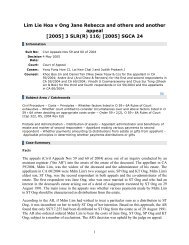
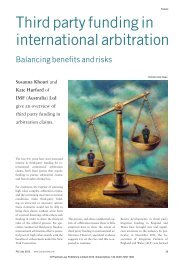
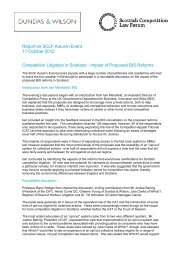
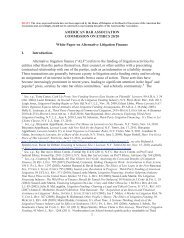

![Hall v Poolman [2009] - Harbour Litigation Funding](https://img.yumpu.com/37488843/1/190x245/hall-v-poolman-2009-harbour-litigation-funding.jpg?quality=85)
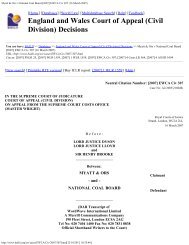

![[2013] SGHC 135 - Singapore Law Watch](https://img.yumpu.com/37488807/1/184x260/2013-sghc-135-singapore-law-watch.jpg?quality=85)
